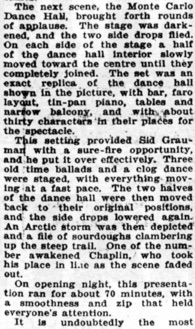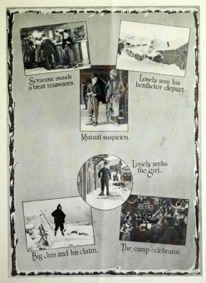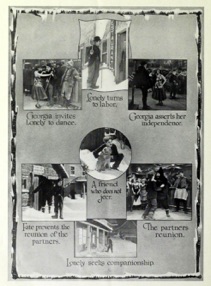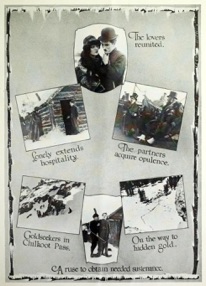The Gold Rush 1923 1924 1926 next previous
The Gold Rush Clippings 192/363
Variety, New York, July 1, 1925.
Six Film Stills (...)
The Gold Rush Program, Egyptian Theatre, Los Angeles,
1925, California State Library
& Seven Film Stills (...)
The Gold Rush Program, Egyptian Theatre, Los Angeles,
1925, California State Library
& Six Film Stills (...)
The Gold Rush Program, Egyptian Theatre, Los Angeles,
1925, California State Library
„Entry of the Lonely Prospector“
Editorial content. „Pictures
House Reviews
Grauman‘s Egyptian
Los Angeles, June 26.
-
1.Overture – Grauman‘s Egyptian Orchestra. Gino
Severi, conducting.
-
2.The Spell of the Yukon, by Robert W. Service.
Interpretative expression by Tyrone Power.
-
3.Scenic Alaskan Spectacle.
-
4.The Land of the Midnight Sun:
a. Entry of the Lonely Prospector.
b. Meeting with the Eskimos.
c. Eskimo Dance.
d. Charlie‘s Dream.
-
5.The Spirit of the Frozen North. As beauty depicts
the moods of the Northland.
-
6.Balloon Dance, by Lillian Powell.
-
7.Festival of the Dancing Ice Skaters.
-
8.The Monte Carlo Dance Hall.
-
9.Charlie‘s Awakening.
Sid Grauman‘s presentations always reach
the highest standards, but he extended himself with Chaplin‘s
Gold Rush, offering a prolog that even surpasses
his previous efforts at this theatre,
After an introduction of the stars assembled,
Gino Severi launched his engagement as the new conductor
of the Egyptian theatre orchestra by directing
a specially arranged medley of semi-classical numbers for
a brief and snappy overture. Tyrone Power followed
with a recital of Robert W. Service‘s Spell of the Yukon.
The stage setting was billed as a Scenic Alaskan
Spectacle, and lived up to its title. The lay out covered the
entire stage, with a back and two side scenic drops
depicting receding bills of snow. A steep trail through the
hills was set backstage, with an Eskimo but nearby.
Blue floodlights and failing snow were used effectively
to portray the Arctic setting.
A character in the make-up of Chaplin entered
from the left, and aroused the Eskimos in their hut, who came
out to step through an eccentric dance. While the
dance was on, the tramp character fell asleep on the trail,
which served to present Charlie Chaplin‘s Dream.
This opened with the presentation of six girls attired
in sparkling silver mesh costumes. The sextet
formed a background for the individual presentations
of six other girls gorgeously gowned in white fur
and silk creations. The introductions were made through
traps in centre stage.
A balloon dance by Lillian Powell was next,
followed by the Festival of Dancing Ice Skaters, a brilliant
and effective dance ensemble consisting of six
men and twelve girls, all attired in white skating costumes.
The next scene, the Monte Carlo Dance Hall,
brought forth rounds of applause. The stage was darkened,
and two side drops flied. On each side of the stage
a half of the dance hall interior slowly moved toward the
centre until they completely joined. The set was
an exact replica of the dance hall shown in the picture,
with bar, faro layout, tin-pan piano, tables and
narrow balcony, and with about thirty characters in their
places for the spectacle.
The setting provided Sid Grauman with a sure-fire
opportunity, and he put it over effectively. Three old time ballads
and a clog dance were staged, with everything moving
at a fast pace. The two halves of the dance hall were then
moved back in their original positions, and the side
drops lowered again. An Arctic storm was then depicted and
a file of sourdoughs clambering up the steep trail. One
of the number awakened Chaplin, who took his place in line
as the scene faded out.
On opening night, this presentation ran for about 70 minutes,
with a smoothness and zip that held everyone‘s attention.
It is undoubtedly the most spectacular stage presentation ever conceived by Sid Grauman.“
The Gold Rush opens June 26, 1925
at Grauman‘s Egyptian, 6712 Hollywood Bld., Los Angeles.
Redaktioneller Inhalt
The Gold Rush 1923 1924 1926 next previous






